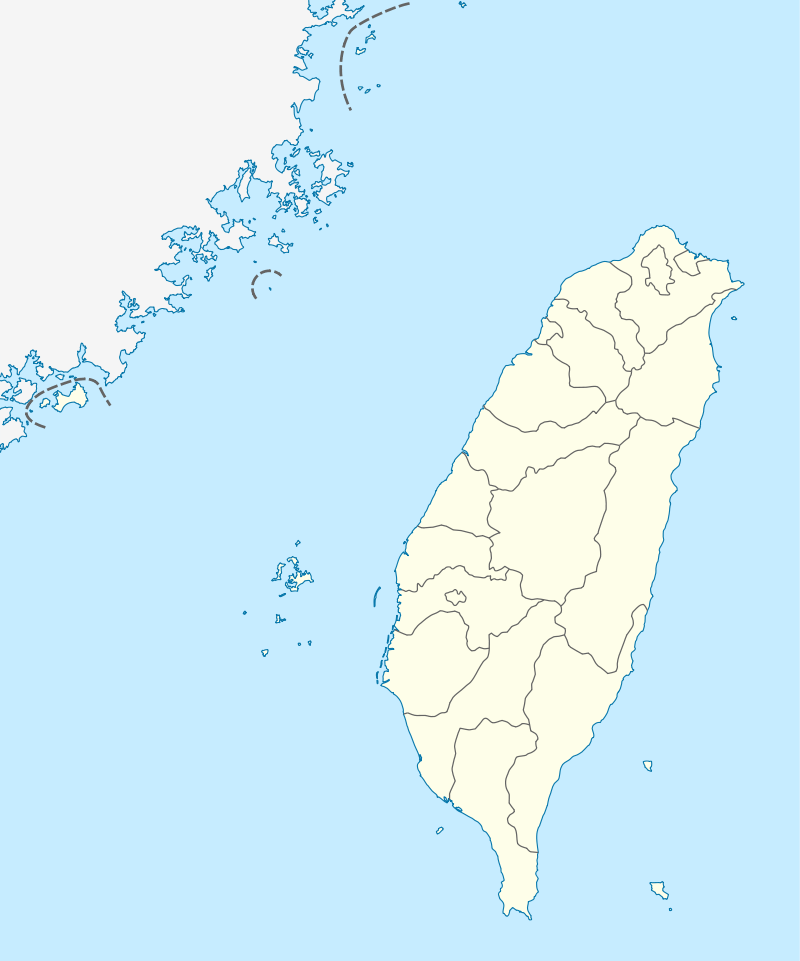National Museum of Marine Biology and Aquarium
 Museum entrance | |||||
 Location within Taiwan | |||||
| Established | 25 February 2000 | ||||
|---|---|---|---|---|---|
| Location |
2 Houwan Rd. Checheng, Pingtung County, Taiwan | ||||
| Coordinates | 22°02′47″N 120°41′52″E / 22.046485°N 120.697678°ECoordinates: 22°02′47″N 120°41′52″E / 22.046485°N 120.697678°E | ||||
| Collections |
Waters of Taiwan Coral Kingdom Pavilion World Waters Pavilion[1] | ||||
| Website |
www | ||||
| |||||
The National Museum of Marine Biology and Aquarium (NMMBA; Chinese: 國立海洋生物博物館; pinyin: Guólì Hǎiyáng Shēngwù Bówùguǎn) is an aquarium located on the southern coast of Taiwan near Kenting (northwest of Kenting National Park) in Checheng Township, Pingtung County, Taiwan.

Overview
Planning for the museum began in 1991, and the museum itself was opened on February 25, 2000.[1] In addition to the museum, the park surrounding the museum is an outdoor water park (the largest in Taiwan).[2]
The total area of the park is 96.81 hectares (968,100 m2), while the museum itself covers 35.81 hectares (358,100 m2). The museum has three main exhibits: Waters of Taiwan, Coral Kingdom Pavilion and World Waters Pavilion.[1] The museum also has an 81-metre (266 ft) underwater moving track, the largest underwater tunnel in Asia.[1] The building also has several major divisions including the experiment center for aquatic life, public facilities, research facilities, maintenance facilities, an international conference center, and an academic research center.
In 2015, NMMBA was rated fourth best of its kind in Asia by TripAdvisor, receiving 4.5 out of 5 stars.[3]
Exhibitions
The museum has three main exhibitions:[4]
Waters of Taiwan
.jpg)
This exhibit hall features aquatic animals native to Taiwan, from waters as small as rivers to as vast as the open sea. The exhibits are themed after the water systems of Taiwan, starting from the river and the reservoir to the intertidal zone and finally to the open sea. There is also a touch pool featuring marine invertebrates in the intertidal exhibit area. Animals on display include tilapia, Japanese eel, trout, cuttlefish, nurse sharks, Indo-Pacific tarpon, yellowfin tuna, spotted eagle rays, and a whale shark.[5] The main ocean tanks contains 5,700,000 litres (1,500,000 US gal) of sea water, has a 16.5 m × 4.85 m (54.1 ft × 15.9 ft) acrylic viewing window and an 80-metre (260 ft) shark tunnel.[6]
Coral Kingdom
The Coral Kingdom exhibit hall shows different coral reef habitats, from shallow waters to deep oceans. Differing environments based on sea depth, pressure, terrain, and light are shown. An underwater tunnel and a sunken ship are also part of the exhibit hall. At the end of exhibit hall is an underwater tunnel and viewing panels showcasing the aquarium's four beluga whales. It is also possible to see the belugas from above water via a pavilion on the second floor. Animals on display include blacktip reef sharks, lionfish, moray eels, cownose rays, unicornfish, butterflyfish, garden eels, and beluga whales.[7]
Waters of the World
This exhibit covers ancient, Precambrian oceans as well as ocean formation.[8]
Research
Besides public exhibition, there is a group of scientists that carry out scientific research in the museum. There are two research buildings and a marine station in the museum, dedicated to research in marine biology and ecology, aquaculture, propagation and conservation of marine fauna and flora. Research carried out at NMMBA includes the effects of pollution on coral and fish[9][10] and the effects of light on the developmental expression of fluorescent proteins.[11][12]
In 1997, the museum provided help to other governmental divisions in dealing with endangered or threatened aquatic animals, and the rescue of grounded dolphins and whales. This is the largest marine biology research unit in Taiwan, working together with other universities and research institutes both in Taiwan and worldwide through joint programs.
See also
| Wikimedia Commons has media related to National Museum of Marine Biology and Aquarium. |
References
- 1 2 3 4 5 "History". NMMBA.org. Retrieved 2010-07-19.
- ↑ "Taiwan's largest outdoor water park 'cooling'". The China Post. 2003-08-18. Retrieved 2010-07-19.
- ↑ "NMMBA rated 4th best aquarium in Asia". Taiwantoday.tw. July 23, 2015. Retrieved July 26, 2016.
- ↑ "Exhibition and display description". NMMBA.org. Retrieved 2010-07-19.
- ↑ "Waters of Taiwan". NMMBA.org. Retrieved 2010-07-19.
- ↑ "National Museum of Marine Biology & Aquarium". internations.org. Retrieved 11 February 2015.
- ↑ "Coral Reef Previews". NMMBA.org. Retrieved 2010-07-19.
- ↑ "Waters of the World". NMMBA.org. Retrieved 2010-07-19.
- ↑ "Taiwan researcher studies coral pollutants". Taiwantoday.tw. November 12, 2013. Retrieved July 26, 2016.
- ↑ Melissa Roth (August 14, 2013). "Taiwan's Coral Reefs and Other Hidden Gems". Livescience.com. Retrieved July 26, 2016.
- ↑ Tsai Chung-hsien and Jason Pan (June 20, 2013). "Coral study may lead to health benefits". Taipeitimes.com. Retrieved July 26, 2016.
- ↑ Te-Hao Chen (2015). "The beauty and sorrow of a tropical paradise: anthropogenic pollution in coastal water of Kenting National Park, Taiwan". Kuroshio Science. 9–1: 39–44.